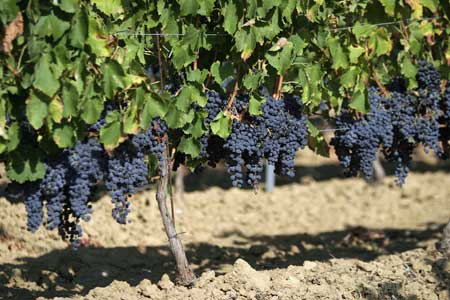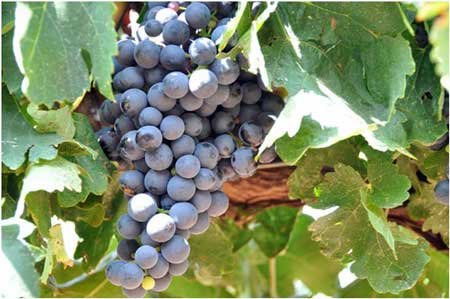(Video: See why Tempranillo is so good for Texas wine growers winemakers and consumers)
Its Time to Join Us for Texas TAPAS: Tempranillo Advocates Producers and Amigos Society Starting a Chapter in Texas
Are you a Texas wine grower, winemaker, or wine consumer? If you are, then it is high time to get saddled up and join the posse of folks leading a wine revolution. Its a wine revolution involving quality wines that are Texas grown, Texas produced and Texas savored made from sun-loving grapes that originate from two countries on the Iberian Peninsula – Spain and Portugal. The attention getter grape so far has been the ring leader of Rioja, Spain: Tempranillo. In Texas, it all started about ten years ago, but of recent, the movement to these grapes has been rapidly gaining support for one good reason – Spanish grapes make good wine in hot, sunny Texas, just as they do back home in Spain.

There has been some recent publicity about growing and making Tempranillo wines in California, and in of all placed, Oregon. Once the word got to the people in the Texas wine industry it got them really fired up.
— — — — —
2010 Texas Tempranillo Symposium
From its beginnings in Spain to its growing popularity as a Texas Red∑ from the vineyard to the bottle, come and explore what is Tempranillo.
Monday, November 22, 2010, the Vineyard at Florence, 111 Via Francesco, Florence, TX 76527
Accommodations: Google Hotels Salado or Georgetown, TX
Early bird Sunday Evening BWOT (bring your own Tempranillo) Reception 7:00-9:00 PM
Monday, 8:00-9:00 AM Check-in, Symposium 9:00 AM ˆ 4:30 PM
Cost: $100 (includes symposium sessions, materials, and lunch)
Register TODAY by clicking http://www.adultedreg.com/cwlgcc/
Topics will include:
–Tempranillo roots deeply implanted in Spain,
–Defining Spanish Tempranillo by wine style∑..”Old world” viticulture blended with “new world” wine production techniques
–Tempranillo expanding its US base as a Texas varietal and as a Texas blend
–Growing Texas Tempranillo for quality and yield
–Examine Texas Tempranillo, wine styles, and wine making techniques
–Sensory analysis
–Panel discussion
Our speakers: Simon Arina Robles, Bodega Baigorri, Rioja, Spain; Jim Johnson, Owner/Winemaker Alamosa Winery; Dr. Bobby Smith, Owner/Winemaker, La Buena Vida Vineyard Springtown; Dan Gatlin, Owner/Winemaker Inwood Estates Winery; Les Constable, Owner/Winemaker, Brushy Creek Vineyards; Neal Newsome, Newsom Vineyards
— — — — —
I asked Jim Johnson, co-owner and winemaker at Alamosa Wine Cellars (www.alamosawinecellars.com) in Bend, Texas, what lit the fire under this movement in Texas, he said, “There could now be as many as 40 producers of wines made from Tempranillo in Texas this year. It’s happened so fast that I really don’t have an accurate count, as yet. What I do know is that this is a big grape crop year in the High Plains, and for Texas as a whole. There has been a lot of Tempranillo planted in Texas now. There will be Tempranillo enough that some wineries who never thought about it in the past, but they will be thinking about making it into wine this year.”
What is TAPAS Society?
The idea for TAPAS (Tempranillo Advocates Producers and Amigos Society – http://www.tapasociety.org) started on the west coast as tool to disseminate information on wines made from Tempranillo and other Iberian varietals. It was basically similar to what the Zinfandel producers did with ZAP (Zinfandel Advocates and Producers). ZAP supporters took Zinfandel from a varietal grown by the old ethnic Italians in California that in the 1970’s was made into sweet Blush wine, and made it a mainstream variety for big red wines that are now enjoyed across the United States.
Jim continued, “There’s more to Iberian varietals than just Tempranillo. Alamosa is growing Tempranillo, Graciano, Garnacha, and Verdelho now, all of which are indigenous to the Iberian Peninsula of Europe that includes Spain and Portugal. Some types of grapes that are generally considered Rhone varietals are also Iberian in origin, cultivation there predating cultivation in France, in most cases. I’m thinking primarily of Grenache, Carignan, and Mourvedre. And let’s not forget the Port varietals, Touriga Nacional and all the Tinta varieties.”
According to Bobby Cox there is more Tempranillo being planted now than any other red variety on the Texas high plains near Lubbock. When Jim’s grower, Mike McHenry, was doing vineyard consulting in the Texas Hill Country last year he found a lot more interest in Iberian and Italian varietals than in the standard grapes made popular by French and California wineries – Cabernet, Merlot, and Chardonnay. There is nothing wrong with trying to grow these varieties of grapes in Texas, and some do it remarkably well. However, a growing number of growers and wine producers feel that if Texas is to get its chapter in the World Atlas of Wine, it will get it for TexMeds (Texas-Mediterranean) wines like Tempranillo and not for its Chardonnay, and certainly not for Texas Pinot Noir.

Texas wine consumers should be interested in Iberian varietals because they make good wines in the Texas climate and soils. Wines made from Spanish grape varieties like Tempranillo also complement our southwestern cuisines that involve grilled meats, fish and spicy accoutrements. They also broaden the field of play and give the consumer more choices, especially those that have the best chance to make the best wines.
Two Important Meetings in November, 2010
Everyone needs to get ready for two meetings scheduled to take place this coming November. As part of the upcoming 2010 Grayson College Enology Outreach Seminar Profiles Series, there will be a Tempranillo Symposium, to be held November 22, 2010 at the Vineyard at Florence, Florence TX. The three featured presenters will be Simon Arina Robles, Bodega Baigorri, Rioja, Spain; Jim Johnson, Owner/winemaker at Alamosa Wine Cellars; Dan Gatlin, Owner/Winemaker Inwood Estates Winery. The fee for the event will be $100. If you are interested in attending the Tempranillo Symposium, register online at: http://www.adultedreg.com/cwlgcc. For additional information contact Bob White at whiteb@grayson.edu.
In regard to the second meeting, Jim said, “My hope for the November meeting is that we also get enough people signed up with TAPAS to hold and organizational meeting of a Texas chapter of TAPAS. That would be really special since no other state currently has one. We will also work to begin making preliminary plans to hold a public tasting of Texas wines made from Iberian varietals, and develop a plan to promote this tasting.
Want to be a TAPAS Member?
There are three classes of TAPAS full voting memberships: Grower, Winery and Amigo (or Friends). These are designed primarily for people that work in the wine industry or that want to support this effort. These three categories have an annual membership fee of $100. There is a forth member category designed for the wine consuming public. It’s called “Sancho Panza” and it FREE! People can join as Sancho Panza members online and it makes you eligible to receive the TAPAS Newsletter and announcements of upcoming events. To join TAPAS in any of these four categories, go to: http://www.tapasociety.org/join.

— — — — —
Acknowledgement for Those that Started the Modern Texas Wine Industry
As a final note, Jim said, “Let me also say that this TAPAS effort is in no way meant to diminish the efforts of our Texas wineries who are making wine from Cabernet, Merlot, Chardonnay and even Pinot Noir. God only knows they try hard and are sometimes rewarded with some truly spectacular wines. What sets TexMeds apart is that they are indigenous to places with climates more like our own in Texas than say cool climate Burgundy, Champagne or Alsace or maritime climates like Bordeaux. Those who started the wine industry in Texas in the 70’s had to grow what consumers recognized and were willing to purchase and in doing so built a following for Texas wine and paved the way for some of us Johnny come latelys to do TexMed wines. For that we owe the Llanos, the Fall Creeks, the Oberhellmans and all the other pioneers of Texas winemaking our gratitude.”

Be the first to comment